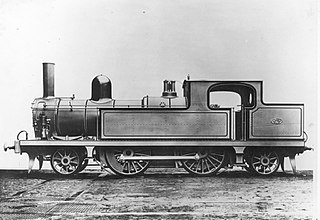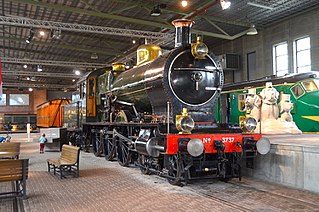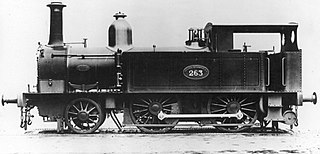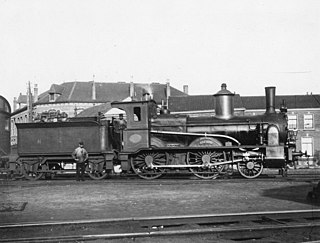SS 301-475
This series followed the 101–105 series. After the introduction of the Westinghouse brake, a system whereby the driver could brake all wagons simultaneously, the speed on the railway network could be increased and the SS decided not to expand the series 101–105, but to purchase new, stronger locomotives.
Between 1880 and 1895, 175 locomotives were built by the Beyer, Peacock and Company of Manchester, England. Because these were the largest 1B locomotives in Europe at the time of purchase and with the light green colour scheme of the SS, these locomotives were nicknamed Grote Groenen (Big Greens).
The tenders of the 301-398 had a water capacity of 10.3 m3. From No. 399 onwards, the water capacity of the tenders was increased to 13 m3 by lowering the tank between the frames. Later on, the water capacity of the tenders was also increased in the same way for the 301–398.
When the fleet of the HSM and the SS was merged into the Dutch Railways in 1921, these locomotives were given the NS numbers 1301–1475, with the NS numbers of 1462–1466 in deviation from the SS numbers 463-466 and 462.
The series was withdrawn from service between 1925 and 1940, with the most going in 1935. [1]
The NS 1326, withdrawn in 1939, was kept for the Spoorwegmuseum and has been returned to its Staatsspoorwegen condition as SS 326. [1]
NBDS No. 6, 7, 11
The mail trains, which had been led via Venlo since 1888, returned in December 1892 to the Boxtel - Wesel, the "German Line". For this, the NBDS ordered three 1'B express locomotives from Beyer, Peacock & Company of Manchester. Unlike No. 8-10, these locomotives were completely similar to the Grote Groenen 301-375 of the SS. In order to be able to deliver of a new locomotive on time despite the delivery deadline, they took the already under construction SS 462 and completed the locomotive for the NBDS and entered service as NBDS 7 in November 1892. A new locomotive, SS 462 was built for the SS.
After the NBDS merged into the SS in 1919, these locomotives were included as SS 476–478 in the fleet of the SS, and two years later, when the fleet of the HSM and the SS was merged into Nederlandse Spoorwegen, they received the NS numbers 1476- 1478. In 1933 No. 1477 was withdrawn. No. 1476 and 1478 followed in 1936. [2] [3]
SS 701
In 1892, Beyer-Peacock built a compound locomotive which was given the number 701 by the SS. With the series 701-706 entering service in 1910, this locomotive was renumbered to No. 479 in 1909. In 1921, this locomotive was given the NS number 1479.
Because the compound system with this locomotive did not yield any savings, the NS rebuild the locomotive in 1924 into a single expansion. In 1936, the locomotive was withdrawn. [2] [3]

War Department (WD) Austerity 2-10-0 No. 73755 Longmoor is a preserved steam locomotive.

De Arend was one of the two first steam locomotives in the Netherlands. It was a 2-2-2 Patentee type built in England by R. B. Longridge and Company of Bedlington, Northumberland to run on the then standard Dutch track gauge of 1,945 mm. On 20 September 1839, together with the Snelheid, it hauled the first train of the Hollandsche IJzeren Spoorweg-Maatschappij between Amsterdam and Haarlem. It was withdrawn in 1857.

The NS 1600 was a series of steam engines of the Dutch national railways, Nederlandse Spoorwegen (NS), and its predecessors Maatschappij tot Exploitatie van Staatsspoorwegen (SS), Hollandsche IJzeren Spoorweg-Maatschappij (HSM) and Nederlandsche Rhijnspoorweg-Maatschappij (NRS).

The NS 5300 class were the first of this class in The Netherlands, in fact the NRS employed the first passenger service tender locomotives with this type. The Westinghouse brake system was a first for the NRS; the additional hand brake was common. To obtain a stable ride at high speeds, inside cylinders were employed. The firebox was situated between the coupled axles. The front and rear axles were of the Webb type, already employed by the London North Western Railway. The radial axle boxes were produced with very fine tolerances. Rubber bumpers were employed to move the axle back into position.

The HSM 190 - 193 were a class of four 1'B steam locomotives build by Borsig for the Hollandsche Spoorweg Maatschappij in 1888. The locomotives were named as was typical for the HSM. These were of the same type as locomotives of the series 184-189 with the exception that these locomotives were compounds. Compounding was introduced in an effort to improve efficiency.

The NS 3700 class was a class of express steam locomotives with the wheel arrangement of 2'C (4-6-0) of Nederlandse Spoorwegen (NS) and its predecessor Maatschappij tot Exploitatie van Staatsspoorwegen (SS).

The NS 3400 was a series of goods steam locomotives of the Dutch Railways (NS), ordered by its predecessor the Hollandsche IJzeren Spoorweg-Maatschappij (HSM).

The NS 3300 was a series of goods steam locomotives of the Dutch Railways (NS) and its predecessor Hollandsche IJzeren Spoorweg-Maatschappij (HSM).

The NS 5000 was a series of tank engines of Nederlandse Spoorwegen (NS) and its predecessor Maatschappij tot Exploitatie van Staatsspoorwegen (SS).

The NS 5600 was a series of steam locomotives of the Dutch Railways (NS) and its predecessors Maatschappij tot Exploitatie van Staatsspoorwegen (SS) and Nederlandsche Centraal-Spoorweg-Maatschappij (NCS).

The NS 600 was a series of steam locomotives of the Nederlandse Spoorwegen (NS) and its predecessor Maatschappij tot Exploitatie van Staatsspoorwegen (SS).

The NS 700 was a series of steam locomotives of Nederlandse Spoorwegen (NS) and its predecessors Maatschappij tot Exploitatie van Staatsspoorwegen (SS) and Noord-Brabantsch-Duitsche Spoorweg-Maatschappij (NBDS).

The NS 7600 was a series of tank engines of the Dutch Railways (NS) and its predecessor Hollandsche IJzeren Spoorweg-Maatschappij (HSM) and Haarlem-Zandvoort Spoorweg Maatschappij (HZSM).

The NS 1700 was a series of express steam locomotives of Nederlandse Spoorwegen and its predecessor Maatschappij tot Exploitatie van Staatsspoorwegen (SS).

The NS 3500 was a series of express train steam locomotives of Nederlandse Spoorwegen (NS) and its predecessors Noord-Brabantsch-Deutsche Spoorweg-Maatschappij (NBDS) and Maatschappij tot Exploitatie van Staatsspoorwegen (SS).
The NS 3500 was a series of steam locomotives of the Dutch Railways (NS), which were acquired second-hand from the Swiss railways SBB.

The NS 6000 was a series of tank engines with the wheel arrangement of 2'C2' of the Dutch Railways (NS) and its predecessor Maatschappij tot Exploitatie van Staatsspoorwegen (SS). They were manufactured by Beyer, Peacock and Company of Manchester, England.

The NS 3600 was a series of express steam locomotives of the Dutch Railways (NS) and its predecessors Maatschappij tot Exploitatie van Staatsspoorwegen (SS) and Nederlandsche Centraal-Spoorweg-Maatschappij (NCS).

The NS 7100 was a series of tank engines of the Dutch Railways (NS) and its predecessors Maatschappij tot Exploitatie van Staatsspoorwegen (SS), Hollandsche IJzeren Spoorweg-Maatschappij (HSM) and Noord-Friesche Locaalspoorweg-Maatschappij (NFLS).

The NS 1900 was a series of express train steam locomotives of the Dutch Railways (NS) and its predecessor Hollandsche IJzeren Spoorweg-Maatschappij (HSM).
This page is based on this
Wikipedia article Text is available under the
CC BY-SA 4.0 license; additional terms may apply.
Images, videos and audio are available under their respective licenses.






























